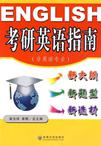考研英语指南
出版时间:2009-9 出版社:东南大学出版社 作者:梁为祥,李刚 页数:208
前言
《考研英语指南》是根据教育部有关部门最新颁布的考研英语《大纲》规定的考试功能和作用以及内容要求的原则而编写的。要求考生要达到的知识、能力和水平目标是全面的、完整的、系统的。根据“大纲”的规定和要求,将本书的内容规划为语言知识和语言技能两大部分。第一部分为语言知识,包括语法知识:语法知识涵盖时态和语态,虚拟语气,非限定动词,主从复合句和某些连词的用法,倒装,强调,否定,反意疑问句,插入语,形容词和副词及其比较结构和特殊用法,句子的完整性和一致性。第二部分为语言运用能力,包括阅读能力和写作水平。其中词汇知识涵盖词义辨析,词语搭配,习语和固定词组的意义,语篇连接。此部分均以完形填空的方式体现词汇的各种用法,并且进行详细的解析。其后还设计了一些练习题,供考生练习提高。阅读理解部分根据试题的设计,分为A、B、C三节。每节都简述考题要点和典型试题分析,同时对试题范例的答案进行详细的解析,引导考生如何准确地做好每一道题目。最后精选练习题,让考生做自测。 根据《大纲》的要求,写作内容包括A、B两节(英语应用文和英语短文)。英语应用文写作主要是考查学生运用英语撰写不同类型的应用文的能力,包括私人和公务信函,备忘录,摘要,报告等。在此部分,对于每一种文体的应用文都设计有:写作要点和范文。 英语短文写作主要是要求考生能够通过短文写作提高英语表达能力以及掌握短文写作要领。在此部分,对于每一种文体的短文都有不同的设计和要求。譬如:在设计每一篇范文时,都有写作特点和要领,提供主题句或写作提纲,规定情景,图表以及范文和点评等,最后配有写作练习,便于学生练习提高。 为了编写出一本紧贴《大纲》的要求,而又能体现“新选材、新题型、新理念”的高质量的考研新教材,以便更加满足非英语专业考生的需求,东南大学、中国药科大学、南京财经大学等高校的英语专家、教授进行了认真的探索,并直接参与编写工作。由东南大学外国语学院梁为祥教授和李刚副教授担任总主编,肖辉、孙瑾、王婕担任主编。在编写和出版过程中,得到了东南大学出版社史建农编辑的大力支持与配合,在此表示感谢。 由于编写工作时间仓促,书中难免会出现不妥和谬误之处,真诚地希望广大读者批评指正。
内容概要
《考研英语指南(非英语专业)》是众多专家、教授集多年的教学经验并根据近年来考试内容的走向,以国家教育部颁发的,《2009年全国硕士研究生入学统一考试英语考试大纲》为依据而精心编写的。《考研英语指南(非英语专业)》的前两个单元重点介绍《大纲》的要求和考试内容的规范,并且从语言知识的角度细化了考试的内容和范围以及考生必须要掌握的基本知识。后三个单元主要紧扣考题的形式和内容进行了详细的讲解与分析,如:语言知识运用,阅读与理解(含翻译)以及写作等。在每个部分都配有大量的讲解分析题和练习题,以此引导考生如何去掌握语言基本知识以及如何去做好每一题目,从而达到提高考生的语言能力和水平。
书籍目录
第一单元 最新考研英语大纲要点(非英语专业)Ⅰ.新大纲要求1.语法2.词汇3.阅读4.写作5.其他方面知识要求Ⅱ.试卷结构要点1.英语知识题2.阅读与理解题3.短文写作题第二单元 最新考研语法要点Ⅰ.语言和语法Ⅱ.语法结构Ⅲ.如何使用主从复合句Ⅳ.掌握特殊句型Ⅴ.形容词和副词的比较级用法Ⅵ.使句子的完整性和一致性的重要性Ⅶ.词汇的理解和运用第三单元 完型填空题型指导Ⅰ.考查要点Ⅱ.范例及解析Ⅲ.练习题Ⅳ.参考答案第四单元 阅读与理解Ⅰ.阅读与理解A节1.测试要点2.扩大阅读量3.扩大词汇量4.善于掌握阅读方法5.加快阅读速度6.解题技巧Ⅱ.阅读与理解B节1.备选题1和备选题22.备选题3Ⅲ.阅读与理解c节1.语言技能2.词汇的理解第五单元 写作Ⅰ.应用文写作Ⅰ)书信类应用文1.私人信2.邀请信3.私人介绍信4.业务介绍信5.求职推荐信6.庆贺信7.求职信Ⅱ)告示类及其他类型应用文1.证明2.报告3.介绍商品4.通告5.请帖6.告示/公告7.请假条8.启事9.学生守则10.摘要11.备忘录12.个人简历Ⅱ.短文写作1.短文写作要点2.图表作文3.描写文4.议论文5.记叙文6.说明文Ⅲ.写作练习一、应用文写作二、短文写作参考文献2009年全国硕士研究生入学统一考试英语试卷
章节摘录
As a young bond trader, Buttonwood was given two pieces of advice, trading rules of thumb,if you will: that bad economic news is good news for bond markets and that every utterancedropping from the lips of Paul Volcker, the then chairman of the Federal Reserve, and the manwho restored the central banks credibility by stomping on runaway inflation, should be respectedthan Popes orders. Todays traders are, of course, a more sophisticated bunch. But the advicestill seems good, apart from two slight drawbacks. The first is that the well-chosen utterances fromthe present chairman of the Federal Reserve, Alan Greenspan, is of more than passing difficulty.The second is that, of late, good news for the economy has not seemed to upset bond investors allthat much. For all the cheer that has crackled down the wires, the yield on ten-year bonds——whichyou would expect to rise on good economic news——is now, at 4. 2%, only two-fifths of apercentage point higher than it was at the start of the year. Pretty much unmoved, in other words. Yet the news from the economic front has been better by far than anyone could haveexpected. On Tuesday November 25th, revised numbers showed that Americas economy grew byan annual 8.2% in the third quarter, a full percentage point more than originally thought, drivenby the ever-spendthrift American consumer and, for once, corporate investment. Just about everyother piece of information coming out from special sources shows the same strength. New housesare still being built at a fair clip. Experts are rising, for all the protectionist crying. Evenemployment, in what had been mocked as a jobless recovery, increased by 125, 000 or thereaboutsin September and October. Rising corporate profits, low credit spreads and the biggest-ever rallyin the junk-bond market do not, on the face of it, suggest anything other than a deep and long-lasting recovery. Yet Treasury-bond yields have fallen. If the rosy economic backdrop makes this odd, making it doubly odd is an apparent absenceof foreign demand. Foreign buyers of Treasuries, especially Asian central banks, who had beenswallowing American government debt like there was no tomorrow, seem to have had secondthoughts lately. In September, according to the latest available figures, foreigners bought only $ 56 billion of Treasuries, compared with $ 25.1 billion the previous month and an average of $ 38.7 billion in the preceding four months. In an effort to keep a lid on the yens rise, theJapanese central bank is still busy buying dollars and parking the money in government debt. Justabout everybody else seems to have been selling.
图书封面
评论、评分、阅读与下载
